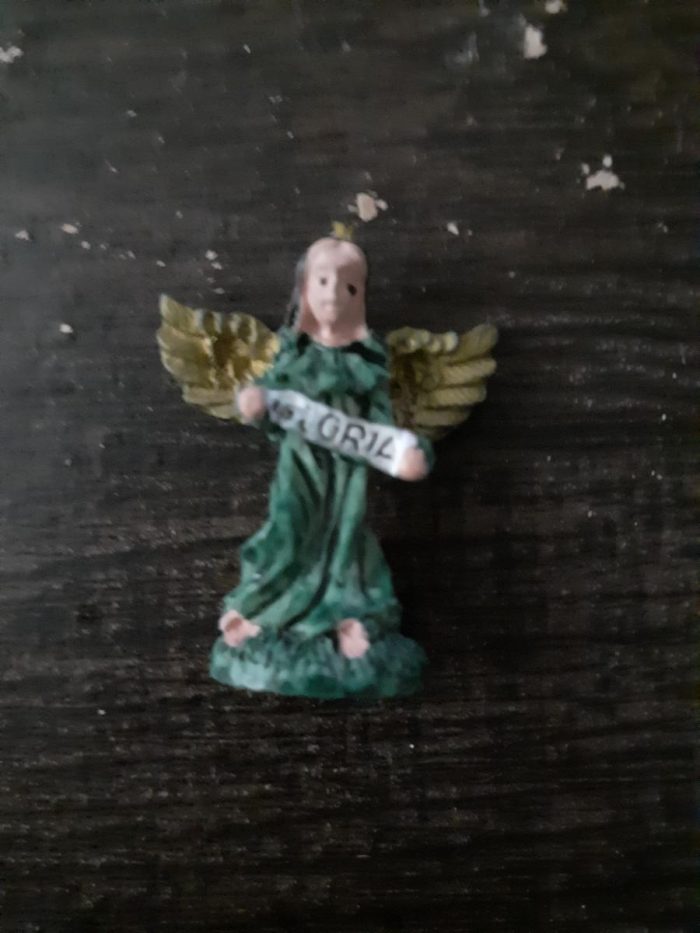“At the end of mirth may be grief.”
Proverbs 14:13
I have a miniature angel. Like many small creations, she is hand painted.
This angel shows this one-of-kind-hand painting, especially when it comes to her face.
Upon closer examination, I was struck by her eyes. Two black dots were painted. But one dot was painted higher than the other. It also appeared to be bigger.
And to me, it denoted a sad expression. It was almost as if that one lower and larger eye was sliding down her face because it was heavy from the tears that were dragging it down.
And contrasting her face profiles, one profile looked more despondent than the other.
This angel, on one side of her face, looked unaffected, peering straight ahead. The other side of her face, however, looked grief-stricken.
Life has sadness and grief built into it.
Some of that comes from realities like death. Some of it comes from loss.
And loss can cover almost anything and anyone. We are subject to that. We can lose a loved one, a belief system, a sense of self and identity. We can lose innocence and faith. These are just some of the deaths and losses that cause us grief.
And there exists a “before and after” to those experiences with that loss and grief.
Like the angel, perhaps one eye is the “before;” one eye is the “after.”
So, what’s in our view?
Things we cannot un-see.
One eye sees life in a certain way.
Ignorance is bliss?
The common phrase, “there is no reality; only perception” rings true for us, doesn’t it?
As individuals, we move through our lives with issues, needs, and circumstances unique to us. We often see through that myopic lens.
In one way or another, it’s just the way it is.
We may believe life is normal, or even ideal. We can believe things are the way we experience them. We have a two-parent family, we are “happy.” There is safety and stability.
“Nothing’s going to change our world.”
We look straight ahead like that, with our mind’s eye. We believe we know what we’re looking at when it comes to our lives.
And then, one day, there is change.
A small change, a series of small changes, a cataclysmic big life-altering event…or even several of them, one after the other.
All the above, in any sequence, can apply.
With change, we learn.
One eye sees the sadness.
“For in much wisdom is much grief: and he that increaseth knowledge increaseth sorrow.”
Ecclesiastes 1:18
We become wise. And with wisdom, there exists grief.
Wisdom has a price tag.
Our viewpoint changes. It saddens us.
That’s a shock to our system.
Sadness carries devastation. It is heavy.
Therefore, there are many of us who have been and are depressed for protracted lengths of time: years and decades. And we had no clue we were depressed a lot of the time. We were so overwhelmed with sadness to notice. Sadness, depression, and grief can masquerade as numbness.
We can be numb. We see only blank, bland, and grey landscapes like that. It’s how we see ourselves. It’s how we see life.
Like the exaggerated larger, lower eye of that angel figure, this sad eye drags us down.
Things we cannot un-live.
Not surprisingly, how we see life eventually becomes how we live life.
Perception can morph into reality.
One eye lives in a certain way.
Coping.
Again, it can be a slow burn. Gradual. Seemingly uneventful, even.
We are used to living with a low quality of life.
For some of us, it’s all we know.
One eye lives with sadness.
“Woe is me for my hurt! my wound is grievous; but I said, ‘Truly this is a grief, and I must bear it.’”
Jeremiah 10:19
But again, there is often one day or one moment in which things change.
There’s a revelation of sadness. It’s gravity that hits us.
Now “living with sadness” takes on a whole new meaning.
Our sad eye enlarges with such pain that we can no longer avoid dismissing it, numbing ourselves to it, and running away from it.
Now, not only do we need to see the grief and the expanse it has taken in our lives, but we also must face it… and do something about it.
That, for many of us, is where trauma therapy comes in.
That is what the sad eye is: trauma.
Unbelievably agonizing pain, intergenerational secrets, issues, and dysfunctions once, to some degree, were comfortably lying dormant.
We didn’t know about them. We didn’t see them. We didn’t feel them.
But now, we do. And that it a scathing ripping process.
There’s a principle that asserts, “what we look at most becomes the biggest thing in our lives.”
And now, we are at a time and a place in which painful, sad, trauma is all we see and live.
Weeding through these memories and the triggers that often accompany them is all-consuming.
We need to embrace the face.
This goes beyond rose-colored glasses. This goes beyond putting on a brave face.
This is about accepting our imperfect face, with its distorted eyes, existing uncomfortably in distressed aesthetics and functions.
We once saw things one way. Now grief makes us see them with a newer despair, a newer broken heart, and a newer disappointment.
Integration. Perspective. Choosing to keep moving, even while we see as we see. Choosing to keep moving, even our eyes are only gaping holes of tears.
Choosing to accept and to keep those newer, larger, more sad eyes opened.
There’s no going back to the previous face, to the previous eyesight.
We see the sad eye, and we will not reject it any longer.
Copyright © 2023 by Sheryle Cruse












Read 0 comments and reply